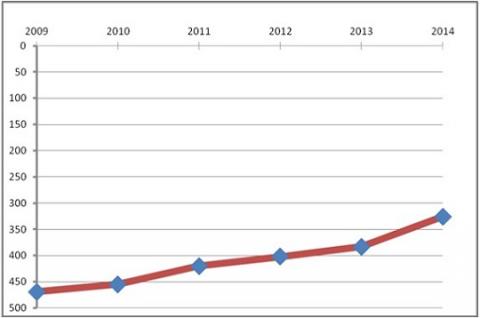
A leading and comprehensive research university
At the UGR, we are thoroughly committed to investing in the future and excelling in research and innovation. Thanks to this sustained commitment, some of the leading research institutes and centres are found at our university.
The excellent infrastructure, facilities and equipment on our campuses allow our 3000+ researchers to stay at the forefront of their respective fields.
Moreover, research at the UGR is thoroughly multidisciplinary in nature. This is demonstrated by the fact that there are currently over 1,400 active lines of research.
Core strengths and the Excellence Initiative
The BioTIC Campus, which incorporates the areas of Biohealth, ICTs, Earth System Sciences, and Heritage and Culture, has been designated a Campus of International Excellence by the Spanish Government. This strategic initiative was created jointly by the Spanish National Research Council (in Spanish: CSIC or El Consejo Superior de Investigaciones Científicas) and the prestigious Health Sciences Technology Park (in Spanish: PTS or Parque Tecnológico de las Ciencias de la Salud)
Biohealth
In Biohealth, the university works in close cooperation with the Health Sciences Technology Park in areas at the forefront of medicine such as gene and cellular therapy, tissue engineering, genomics, molecular oncology and biotechnology and food technology.
Information technology
In Information Technology, the GENIL (Granada Excellence Network of Innovation Laboratories) programme brings together research in the areas of ICT, Mathematics, and Computational Physics, drawing on the active participation of the UGR’s ICT Research Centre, the Granada branch of the Spanish Institute of Mathematics, and the Carlos I Institute of Theoretical and Computational Physics.
Earth systems
In Earth Systems, geologists, geographers, ecologists, environmental scientists and engineers, biologists, chemists and physicists come together in pursuit of a deeper understanding of the physical and biological structure, and of the natural functioning, of the Earth. Geosciences, Geochemistry and Geophysics, Environmental Sciences and Water Resources are some of the most productive areas.
Heritage and culture
The extraordinary heritage of the city and province of Granada, home to two World Heritage Sites, the Alhambra and Generalife complex and the Albaicín quarter, together with the university’s own rich architectural and documentary heritage, mean that it is extremely well placed to carry out cutting-edge research in this broad area. It covers a wide variety of multidisciplinary and interdisciplinary approaches to heritage including archaeology, conservation and restoration, musical heritage, language and accessibility.
The UGR in International Research Rankings
In the most notable international ranking system, the Shanghai Academic Ranking of World Universities (ARWU), the UGR has consistently improved its position for the last five years, having climbed a total of 143 places. It now occupies its highest position ever since this ranking was first launched: 326th in the world.

It is the highest ranking Spanish university beyond the cities of Barcelona, Madrid and Valencia, and is the only one to appear in the 2014 edition of ARWU that is not located in a capital city of one of the Autonomous regions.
From the perspective of specialist areas in the ARWU rankings, the UGR is outstanding in Computer Science (ranked 42nd in the world) and Mathematics (ranked among the top 101-150 in the world). With regard to broader subject fields, the UGR is ranked among the top 101-150 universities worldwide in the discipline of Engineering.
Over this same five-year period we find a similar trend reflected in another prestigious ranking system, the Scimago Institutions Rankings (SIR), in which the UGR has climbed some 84 positions to achieve its best year yet in 2014: 305th in the world.
Meanwhile based on data available since 2011, the UGR has moved up some 55 places in the University Ranking by Academic Performance (URAP), attaining the 205th position, once again its highest performance ever in this ranking.
Knowledge transfer and socio-economic impact
We collaborate locally, nationally and internationally with both public institutions and private companies, via research and service contracts, in order to guarantee exceptional scientific output, and ensure that our innovation and research is applied practically for the betterment of society.
Our institution’s commitment to improving training and research techniques, knowledge transfer, and socio-economic engagement, has enabled us to create over 82 spin-offs, set up over 580 active research projects, and patent over 230 products in recent years. All of these advances have been achieved in line with the highest standards of corporate social responsibility.
UGR Research Profile in Figures (2016)
| Research Projects | Active | Funding obtained |
|---|---|---|
| EU projects | 43 (9%) | €11,514,477 |
| National R&D projects | 353 (71%) | €26,085,315 |
| Andalusian Research Plan | 99 (20%) | €13,075,032 |
| Total | 495 | €50,674,824 |
| of which are EU FP7 projects | 66 | |
| of which are EU H2020 projects | 25 |
| Researchers | |
|---|---|
| Teaching staff in civil service | 2,044 |
| Contracted teaching & research staff | 1,515 |
| Total | 3,449 |
| Research groups | 365 |
| Outputs | |
| Patents created between 2010-2014 | 107 |
| Total Patents in force | 230+ |
| Spin-offs created between 2010-2014 | 47 |